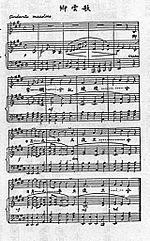| National anthems of China | ||||||||||||||||||||||
|---|---|---|---|---|---|---|---|---|---|---|---|---|---|---|---|---|---|---|---|---|---|---|
|
||||||||||||||||||||||
The Song to the Auspicious Cloud (Chinese: 卿雲歌; pinyin: Qīng Yún Gē; lit. 'Auspicious Cloud Song') was the title of two historical national anthems of the Republic of China. The first version was composed in 1896 by Jean Hautstont, a Belgian composer and esperantist, and was in use from 1913 to 1915 as a provisional anthem. The second version, composed by Xiao Youmei, was in use from 1921 to 1928 as an official national anthem. The lyrics of both songs were based on Commentary of Shang Shu (尚書大傳) written by Fu Sheng in 200–100 BCE.
History
The lyrics of the two versions of the Song to the Auspicious Cloud were based on a song written in Commentary of Shang Shu, which was said to have been sung by the ancient Chinese Emperor Shun, when he passed on the throne to Yu the Great. Its original lyrics in classical Chinese were:
- 卿雲爛兮,糺縵縵兮。日月光華,旦復旦兮。
"How bright is the Auspicious Cloud, How broad is its brilliancy.
The light is spectacular with sun or moon, How it revives dawn after dawn."
The image of the song symbolized transfer and changing, which referred to the noble demise system of Chinese emperor relinquishing seats to others in Yao and Shun's era before the hereditary system of monarchy in ancient Chinese legends. After the end of the monarchy and the establishment of the republic, the lyrics of the classical song was favored by many to become the national anthem by the new government.
First version (1913–15)
| English: Song to the Auspicious Cloud (first version) | |
|---|---|
Former national anthem of | |
| Music | Jean Hautstont |
| Adopted | April 28, 1913 |
| Relinquished | May 23, 1915 |
| Audio sample | |
A national anthem committee was established in July 1912 by Cai Yuanpei, the Minister of Education of the Republic of China. Representative Wang Rongbao (汪榮寶), added another quotation from Emperor Shun: "時哉夫,天下非一人之天下也" (Time has changed, the whole nation is no longer owned by one person.) in the last line of "Song to the Auspicious Cloud" and invited Jean Hautstont, a Belgian composer and esperantist, to compose an anthem. On April 8, 1913, the national anthem was used in opening ceremony of the first regular council. It was a provisional anthem until "China Heroically Stands in the Universe" became the national anthem of the Republic of China on May 23, 1915.
| Traditional Chinese | Pinyin | English translation |
|---|---|---|
|
|
|
Second version (1921–28)
| English: Song to the Auspicious Cloud (second version) | |
|---|---|
 Second version of "Song to the Auspicious Cloud" Second version of "Song to the Auspicious Cloud" | |
Former national anthem of | |
| Music | Xiao Youmei |
| Adopted | March 31, 1921 |
| Relinquished | 1928 |
| Audio sample | |
In November 1919, Duan Qirui established the National Anthem Research Committee (國歌研究會), which adopted the second version of the "Song to the Auspicious Cloud". Lyrics (1920) by Zhang Taiyan from the classic "the Song to the Auspicious Cloud" (卿雲歌) from the Commentary of Shangshu. Music (1921) by Xiao Youmei.
It was selected to be the official anthem on March 31, 1921, by No.759 presidential decree, and was released in July 1921 by the Department of National Affairs (國務院).
| Traditional Chinese | Pinyin | English translation |
|---|---|---|
|
|
|
- ¹糺 (jiū "collaborate") is sometimes written as 糾 (jiū "investigate") or 織 (zhī "to web")
It was replaced by the current national anthem of the Republic of China, which is also the Kuomintang party anthem, in 1928, as a result of the Northern Expedition from 1926 to 1928 and the overthrow of the government. However, during the Second Sino-Japanese War, several collaborationist governments established by the Japanese army, such as the Provisional Government of the Republic of China and the Reformed Government of the Republic of China, also used this anthem, as these governments recommissioned all the old republican national symbols before the Kuomintang came to power in 1928.
See also
References
External links
| Preceded bySong of Five Races Under One Union (1912–1913) |
Song to the Auspicious Cloud 1913–1915 |
Succeeded byChina Heroically Stands in the Universe (1915–1921) |
| Preceded byChina Heroically Stands in the Universe (1915–1921) |
Song to the Auspicious Cloud 1921–1928 |
Succeeded byThree Principles of the People (1928–Now) |